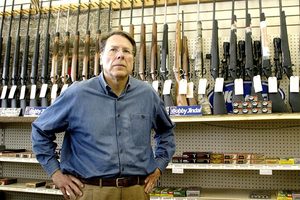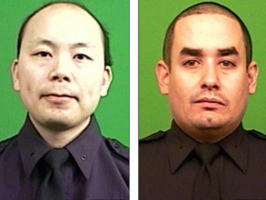It has been a week since Ismaayl Brinsley, a deranged man with a long criminal record, killed two New York City police officers, Wenjian Liu and Rafael Ramos, in cold blood, but so far we haven't heard a word from the National Rifle Association (NRA).
It was Brinsley who pulled the trigger on the silver Taurus semiautomatic handgun that he used to kill the two officers, but the NRA and its fanatic Executive Vice President Wayne LaPierre also have blood on their hands. LaPierre, who has worked for the NRA since 1978 and served as its top official since 1991, is the organization's hit man when it comes to intimidating elected officials to oppose any kind of sensible gun control laws, including a federal law requiring background checks on would-be gun buyers and a national registry of guns. LaPierre likes to fulminate about gun owners' rights. But he's been silent on the ambush of the two New York cops.
Patrick Lynch, the president of the Patrolmen's Benevolent Association, is garnering headlines by blaming New York City Mayor Bill de Blasio for encouraging protests against police killing of black men which, he claims, has created a political atmosphere that led Brinsley to target the two police officers, gunned down while they sat in their squad car outside a Brooklyn housing project.
This is absurd. For one thing, de Blasio has been a strong defender of New York's police department, but he has also criticized police abuses and supported people's right to protest nonviolently. Equally important, Lynch must know that Brinsley was not making a political statement when he shot the two officers. Brinsley's sister told the media that her brother was "emotionally troubled" and suicidal. "He needed help," she said, "He didn't get it." He killed himself after murdering Ramos and Liu.
If Lynch wants to point the finger of blame for his colleagues' deaths, he should focus on the NRA, not de Blasio. For decades, the NRA has fought every effort to get Congress and states to adopt reasonable laws that would make it much less likely that people like Brinsley would be able to obtain a gun. The NRA even defends the right of Americans to carry concealed weapons in bars, churches, schools, universities, and elsewhere. This poses a huge threat to police and civilians alike.
The news media will spend an inordinate amount of effort trying to figure out what was in Brinsley's head before he shot and wounded his ex-girlfriend at an Owings Mills, Maryland apartment complex, posted anti-police messages on social media, then traveled to Brooklyn, where he fired his gun several times through the window of a parked police car, killing the two police officers.
Although the psychology and motives of the murderer may be fascinating, it should not be the major focus. There are plenty of deranged people in the world, but in most well-off countries they can't easily get their hands on a firearm.
Brinsley had a history of criminal activity as well as mental instability. In 2008, he was convicted of felony shoplifting, which made it illegal for him to buy or carry a gun under federal law. Three years later, after he shot a women's car with a stolen handgun, he admitted to other crimes. According to police records, he was arrested 19 times in Ohio and Georgia.
Investigators have traced the gun Brinsley used to kill Ramos and Liu to the Arrowhead Pawn Shop in Jonesboro, Georgia, south of Atlanta. The gun was purchased there in 1996. The buyer told police that he gave the gun to a cousin, according to the New York Times.
Federal investigators are trying to figure out what happened to the gun since then, but the lack of a legal paper trail makes doing so difficult. There have been no traceable purchases since then, so law enforcement officials don't know if Brinsley purchased the gun from an individual, or a website, or a gun show, or whether he stole it.
As of 2010, Georgia was the fifth-largest source of guns used in crimes nationally and the largest source of out-of-state guns seized by the New York Police Department, the Times reported. Of the 2,433 guns used in crimes in New York City whose point of sale can be traced, 90 percent come from out-of-state, most of them from states with few restrictions on selling or buying guns. Officials call the gun trail between Georgia and New York City the "iron pipeline."
According to a New Republic article by Rebecca Leber: "In fact, it's weak gun laws that enable felons, domestic abusers, and the mentally ill to arm themselves. Whereas licensed gun sellers must conduct background checks, unlicensed secondary market sellers face no such requirement in more laissez-faire states," like Georgia.
Leber explained:
New York requires all gun sales, including private ones, to pass a background check. Georgia does not. It also has no penalties for straw purchasers who buy firearms legally for someone who can't. It also doesn't mandate that gun owners file a police report when their gun goes missing. In 2014, Georgia's weakened its laws even further, and now gun owners can carry firearms into bars, classrooms, government buildings, and even TSA airport checkpoints. Felons are allowed to invoke the controversial Stand Your Ground defense, meaning they don't have the obligation to retreat if they feel their life is threatened. Georgia's own murder rate is 27 percent above the national average, and has the 13th most permissible gun laws in the nation, according to a Daily Beast analysis.
In 2012, there were 32,288 deaths from firearm violence in the United States, including 11,622 homicides (32 a day) and 20,666 suicides. Firearms were used in 69.6 percent of all homicides that year. Of course, many more people are injured -- some seriously and permanently -- by gun violence.
The NRA has two knee-jerk responses to this. The first is that the Second Amendment gives all Americans the right to possess guns of all kinds -- not just hunting rifles but machine guns and semi-automatics. Efforts to restrict gun sales and ownership is, according to the NRA, an assault on our constitutional freedoms.
The second is the cliché that "guns don't kill people, people kill people." To the NRA, gun laws have nothing to do with the epidemic of gun-related killings.
Both of these arguments are bogus, but the NRA has the money and membership (4 million) to translate these idiot ideas into political clout to thwart even reasonable gun-control laws.
Most gun-related deaths are committed by people who purchase their weapons legally. Others purchase or steal them illegally, but their ability to get access to guns is due to our lax laws on gun ownership. The NRA's job is to make it easier for people to buy and use guns. And so far it has been very successful. Since the 1994 assault-weapon ban expired in 2004, Congress hasn't enacted any major gun regulations.
After 20 children and six adults were murdered at the Sandy Hook Elementary School in Newtown, Conn. in December 2012 by a single killer, gun control advocates thought that they could persuade Congress to pass a new assault weapons ban or at least expanded background checks. But the NRA led a campaign to thwart them and both proposals went down to defeat. In fact, since the Newtown massacre, most new state laws have loosened, rather than tightened, gun restrictions, according to the Pew Research Center.
One of the NRA's biggest victories occurred in 2003, when passed a law sponsored by Rep. Todd Tiahrt, a former Republican congressman from Kansas, that makes it more difficult for public safety officials to shut down the illegal market in gun sales. And handful of gun dealers -- like the Arrowhead Pawn Shop in Georgia -- are responsible for most of the guns used in crimes and seized by law enforcement officials. The Tiahrt amendments restricted the ability of the federal Bureau of Alcohol, Firearms and Tobacco (now called the Bureau of Alcohol, Firearms, Tobacco, and Explosives) to share information on firearms used in crimes with local and state law enforcement agencies and with the public. The amendment requires that the records about gun buyers obtained in state- and local background checks be destroyed within 24 hours of approval. This makes it more difficult to identify gun dealers that falsify records or buyers who make "straw" purchases on behalf of others, many of whom cannot legally purchase guns.
Thanks to the NRA, it is no accident that the United States ranks first in the world -- by a wide margin -- in gun-related civilian deaths and injuries. Compared with every other democracy, we have the most guns per capita and the weakest gun laws. But the danger isn't simply the number of guns; it is the type of guns we allow people to legally purchase. Other countries permit hunting rifles. But the NRA believes that Americans have a right to own an assault weapon.
Even in countries with strong gun-control laws, some people will get their hands on a weapon and destroy others' lives. The tragic killing in Norway in 2011 is testament to this reality. (Although let's recall that Anders Breivik bought $550 worth of 30-round ammunition clips from an American gun supplier for the rifle he used to kill 69 Norwegian kids at a summer camp. Thanks to American laws, it was a legal online purchase.) But the shooting in Norway was an infrequent occurrence. In fact, the U.S. is off the charts in terms of murder rates. The homicide rate in the U.S. in 2012 was 4.67 per 100,000 population compared with 0.35 in Japan, 0.81 in Germany, 0.86 in Sweden, 1.18 in France, 1.60 in Canada, and 2.25 in Norway.
Here's where the NRA comes in. According to the Center for Responsive Politics, since 1990, the gun lobby, led by the NRA, has contributed over $33 million to candidates for Congress and the White House, 88 percent of it to Republicans. It has also invested, since 1998, more than $100 million in lobbying federal government officials.
Under LaPierre's leadership, the NRA has not only dramatically expanded its ties to the gun manufacturers, but has also linked the NRA to the far right, including the Tea Party. LaPierre is a regular presence at gatherings of extreme right-wing groups, whose paranoid warnings about the threat of tyranny and Obama's secret plan to confiscate all guns are meant to scare Americans into buying more guns and joining the NRA. For example, in a speech at the 2012 Conservative Political Action Conference in Washington, LaPierre said that President Barack Obama was part of a "conspiracy to ensure re-election by lulling gun owners to sleep." Obama's plan, he said, was to "erase the Second Amendment from the Bill of Rights and excise it from the U.S. Constitution."
"We must declare that there are no shades of gray in American freedom. It's black and white, all or nothing," LaPierre said at an NRA meeting. "You're with us or against us."
Although the NRA likes to portray itself as representing grassroots gun owners, the bulk of its money comes from gun manufacturers. LaPierre, who makes $974,867 a year, is really a corporate lobbyist.
Only a tiny proportion of the nation's gun owners are NRA members. About 90 million Americans own guns. The NRA claims to have about four million members. That is less than five percent of all gun owners. The NRA's positions are at odds with those of most Americans, most gun owners, and even many NRA members.
A 2013 Pew Research Center poll found that 66 percent of Americans supported the creation of a federal database to track gun sales and 54 percent supported a ban on sale of assault-style weapons. A Pew survey earlier this year discovered that 81 percent of all Americans, and 74 percent of households with NRA members, support background checks for private gun sales.
Gun ownership is highly concentrated. Twenty percent of gun owners possess about 65 percent of the nation's guns. The NRA is able to mobilize a small but very rabid and vocal group of gun owners -- as well as owners of gun shops -- to attend rallies, write letters to newspapers and comments on blog sites, and contact elected officials.
Josh Sugarman, executive director of the nonprofit Violence Policy Center who has written extensively about the NRA, says that the organization's most vocal members are a small proportion of its members for whom "guns are their life." They represent perhaps a few hundred thousand members. Yes, they can make lots of noise but they don't represent the general public or even most NRA members who don't fall for LaPierre's extremism.
Every American grieves for the families and friends of the two police officers killed in New York City on December 20. But until we tame the power of the NRA, we can expect more killings like this, a part of the deadly daily diet of murders throughout America committed by angry gun-toting people whose "freedom" to own weapons of mass destruction that the NRA defends.
Peter Dreier teaches Politics and chairs the Urban & Environmental Policy Department at Occidental College. His most recent book is The 100 Greatest Americans of the 20th Century: A Social Justice Hall of Fame (Nation Books, 2012)


